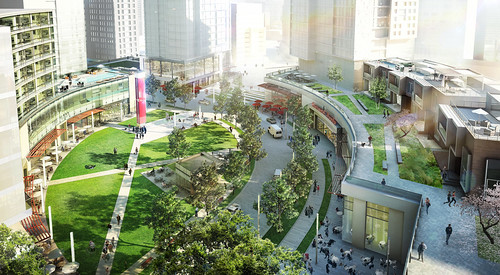 |
| Today it's a parking lot, but this is what the Blairs could look like in the future. All images courtesy of Sasaki Associates. |
With 1400 apartments, a strip mall and an office building around a huge parking lot, the Blairs are a suburban relic in the middle of downtown Silver Spring. Over the next 15 to 20 years, it could become a city in its own right, with new housing, commercial space, and a network of new streets and parks.
The Rockville-based Tower Companies showed me their long-term plan for the redevelopment of the 1960's-era 27-acre complex bounded by Colesville Road, East-West Highway, Blair Mill Road and Eastern Avenue on Wednesday before presenting it to the community that evening at the Silver Spring Civic Building.
The project, which could cost $625 million, would double the amount of housing and tripling the amount of commercial space there is today, which is already allowed under current zoning. The shopping center, office building, and older apartment buildings would be replaced with acres of new parks, courtyards and buildings with green roofs.
Canadian architect Bing Thom, who designed the new Arena Stage in Southwest DC, developed the plan with landscape architect Alan Ward of Boston-based Sasaki Associates, who designed Reston Town Center. "As an architect, it's such a joy to work with [Tower]," says Thom. "Here's a private property owner that says 'We want everyone to walk through our property!'"
Plan proposes new street grid, network of parks
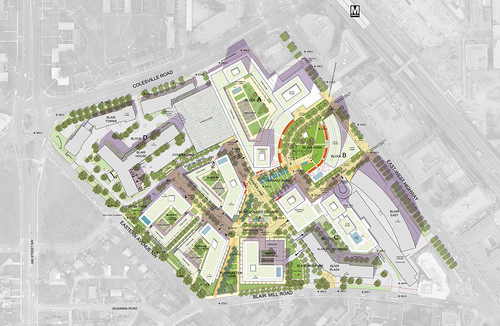 |
| Site plan of the redeveloped Blairs. Click here for a really, really high-resolution version. |
Thom describes the Blairs Master Plan as a "transition from suburban to semi-urban to urban." The tallest buildings, located closer to East-West Highway and the Silver Spring Metro station, would reach 200 feet in height, stepping down to 140 feet and then 40-foot tall townhouses across from the single-family homes on Eastern Avenue.
Each of the 10 new apartment, office and hotel towers sits atop a podium of structured parking, which is capped by a private courtyard or roof deck and wrapped by either townhouses with ground-floor entrances or ground-floor retail. In Vancouver, where Thom is based, this type of building is called a "point tower."
Not only do the townhouses lend the high-rises a more human scale, but they provide a type of housing that isn't very common in downtown Silver Spring. "It's a house in the city," says Thom. "For young families and households with pets, they'll be very popular."
A new street grid with extensions of Draper Lane and Portal Drive NW, new streets, and pedestrian passages, breaks up the existing superblock. The new streets tie the site into the surrounding community and make circulation easier, but are designed to discourage through traffic. Meanwhile, a series of open spaces totaling over 4 acres creates a connection between the Silver Spring Metro station and Rock Creek Park.
"What was once one block is now more permeable," says Ward. "We worked as a team to shape the blocks and make this interesting network of public spaces."
Draper, which exists today as a parking ramp, will become a real street with sidewalks and bike lanes. It divides the site, which has a 25-foot drop between the east and west sides, into what Thom calls the "upper and lower escarpment."
 |
| Blair Park could be set up for special events like markets and performances. |
The "upper escarpment," closer to East-West Highway, replaces the existing shopping center and the office building on Colesville Road with a "lively," mixed-use district with shops, offices, a hotel and about 700 new apartments. It's centered on Blair Park, a one-acre, oval-shaped park oriented to guide people to and from the Metro. Ward envisions it as a major gathering space that can host festivals and concerts, but can still feel comfortable for everyday activities.
Surrounding the park are shops, a new grocery store, and restaurants with outdoor seating. It's lined by a street that is "designed for pedestrians, but cars happen to go through it," says Ward.
Closer to Eastern Avenue is the "lower escarpment," with a more "relaxed, residential" character. Blair Towers, 257 apartments in 4 mid-rise buildings constructed in 1959, would be replaced by roughly 1000 apartments and townhomes in four new blocks. They'll be allowed to remain until their leases expire throughout the next year, though the Tower Companies says they'll allow residents to move to vacant apartments elsewhere in the complex and help pay their moving costs.
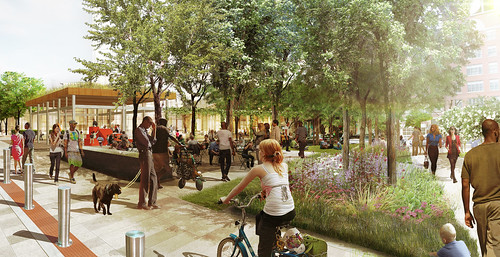 |
| Montgomery Square would have outdoor seating and a playground. |
Another open space, called Terrace Park, provides a transition between the upper and lower escarpments with a gentle sloping lawn criss-crossed by ramps and a water feature that collects and recycles rainwater. At the bottom is Montgomery Square, which has outdoor seating and a children's "imagination playground." Throughout the lower escarpment are a series of smaller pocket parks leading to Eastern Avenue and Rock Creek Park, including a "fitness park" or outdoor gym, and two dog parks.
When finished, there would be 2,800 apartments and townhomes, 1,700 of which would be new; 200,000 square feet of office space; 125,000 square feet of retail space, including a new grocery store; and a 125-room hotel. With the exception of Blair Towers, all of the other apartments in the complex, which were either recently renovated or newly built to LEED standards, would remain.
Murn says he hopes to file a project plan with the Montgomery County Planning Department in March and anticipates that the entire approval process should take between 16 and 18 months. If everything goes as scheduled, work on the lower escarpment would begin in the fall of 2014 and occur in 4 phases. Later, the shopping center and office building would be redeveloped in 3 additional phases. Since Giant's lease doesn't end until 2024, it may take 15 to 20 years for the entire project to be completed.
Residents concerned about parking, open space and displacement
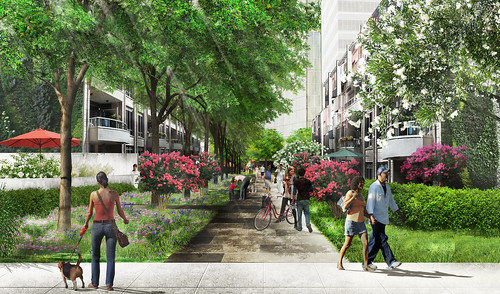 |
| A mews, or pedestrian passage lined with townhouses. |
Reaction to the project at Wednesday's presentation was generally positive, though several concerns were raised.
Residents of Shepherd Park, located across from the Blairs in the District, say the redevelopment will exacerbate an existing parking shortage. The Blairs Master Plan proposes 3300 parking spaces, nearly twice what's there today, including a parking garage that would go over part of Draper Lane.
Ed Murn, director of development for the Tower Companies, says he intentionally "overparked" the site, providing more parking than tenants are likely to use. This may be due to the county's zoning requirements, or demands from retailers.
It's likely that some parking will go unused. The Blairs are across the street from one of the region's largest transit hubs and a short walk to major employers and shopping and should attract people who don't want or need to drive. Most people living in downtown Silver Spring already get around by foot, bike or transit. Structured parking is really expensive to build, especially if it won't be used. If it's possible to reduce the amount of parking on site, the developers should go for it.
Blair Towers tenants say they're worried about displacement and not being able to find affordable housing in the area. Rents continue to rise in Silver Spring despite an apartment building boom, though low vacancy rates suggest there isn't enough housing to meet demand.
As many as 210 apartments will be set aside as Moderately Priced Dwelling Units for low-income households. Murn argued that adding new housing while keeping some of the old will provide more affordable options. "I'm gonna have older buildings at lower price points than the newer buildings at higher price points," he says.
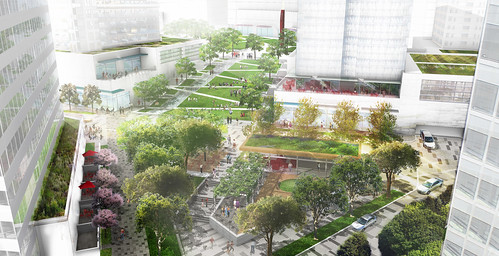 |
| Terrace Park (background) and Montgomery Square (foreground). Will spaces like this be truly public? |
There's also a growing desire for open space in the area, raising the question of how public the Blairs' open spaces will be, since they are all privately owned. In 2007, Montgomery County determined that Ellsworth Drive, which was leased to a private developer, was a public forum where people have the right to free speech.
Murn stresses that the public spaces will be "open and inviting," though he didn't say what restrictions may be placed on them. "Without private ownership, it's impossible for Tower Companies to provide programming our tenants and neighbors would want," says Murn, adding, "The activity doesn't come without the public."
The Blairs Master Plan will breathe new life into a section of downtown Silver Spring that's seen a lot of residential and office development but little else. Even residents who were worried about the project had good things to say about it and praised the detail of the developer and design team's presentation. Many asked for them to hold more community meetings so others could learn about it and offer input.
"This project is so large and so important to the future of Silver Spring that it demands more public comment," says Evan Glass, chair of the Silver Spring Citizens Advisory Board. "An open process is usually a good process."
Check out this slideshow with detailed images of the Blairs Master Plan.

5 comments:
I've lived in SS since 1975. My agency, NOAA, moved to SS in '93, right across the street from The Blairs. This is exciting stuff to someone who remembers the ghost town that was SS in the 70s and how dreary it still was 20 years later when NOAA moved there (I would like to see NOAA get more credit for beginning the revitalization of the downtown btw). This is just what SS west of the RR tracks needs! Everyone who works or lives on the west side of the tracks are cut off from downtown SS with just two ways into the downtown: Colesville Rd or Georgia Ave These shops and restaurants will have a large customer base of people who are blocked by the tracks from easily going downtown. As someone who resists the exuberance of architect's renderings of the final project - filled with attractive, happy people with no litter or graffiti anywhere - nevertheless, I'm smitten with the overall design.
I didn't realize this tract has a 40-50 foot change in elevation, making the 20 story buildings along E-W Hwy look even taller from Eastern Ave. and 16th St. Wow.
I'm excited. I'm also 67 so please build this quickly!
This proposal has a lot going for it. But I have to disagree with author in that there may be too much parking. Between the housing units and retail space the demand will be there. Yes we have policies trying to reduce car ownership, but I just don't see it happening. I believe any unit with more than 1 adult over the age of 24, will have at least one car.
When visiting a friend at the Blairs this weekend, what was the issue; parking for guests.
This is an issue even for the young as my 27 yr old daughter changed apartments in Bethseda from a close in apartment to one further up the pike, because the old place had no parking for guests, so friends were unable to visit.
I lived in the Blairs in 1980 and now live in East Silver Spring, my concern is now becoming what does all this growth do to traffic on the secondary roads in the area.
As I said in the post, 60% of downtown Silver Spring residents currently don't drive to work - they walk, bike or take transit. That's a recipe for low car ownership, especially in an area where there are so many things within walking distance. Ed Murn from the Tower Companies has said the ratio of parking space per apartment will actually go up under this plan, there very well could be a surplus of parking.
Because of it's location, the project will generate far fewer car trips than if it weren't in the middle of downtown Silver Spring. That doesn't mean no one is going to bring a car, but it's going to be far lower than it would be in, say, Burtonsville, where there isn't as much you can walk to.
I have plenty of friends who live in places like Columbia or Fairfax and keep cars, but have many others who live in Adams-Morgan or Columbia Heights and don't have cars. I'm pretty confident that it's the latter type who'll be drawn to places like the Blairs in the future.
Dan
I think you are missing the point when it comes to car ownership, it is not how you get to work in. I have only driven to work for the 3 years I worked in White Oak, for all others I have always commuted by bus, metro or walking. I have lived in Brentwood, Silver Spring, U St DC and Springfield VA (there it was slug line). However I have always owned a car, people like their cars for weekends, shopping etc. Once you own one very few give it up, yes living in a downtown may delay the car a few years because of th ZIP and Cars2go
and how expensive it becomes due to lack of parking, when parking isnot provided then it commands a premium price. My friend at the Blairs is already paying $75 a month. The upside of this is that less parking means less cars which means less traffic for neighboring communities (ie me).
"Parking lot to remain parking lot until at least 2024; long-time residents to be kicked out of downtown Silver Spring by February 2014" better summarizes the vision announced last February by the owner and manager of the Blairs, the Tower Companies.
The announced vision raises some questions:
1) Why must we wait another decade to turn the parking lot into a park?
2) Why must we demolish existing buildings before building new ones, effectively pushing hundreds of long-term residents out of downtown Silver Spring?
3)Why has it taken a decade since additional housing was approved in 2000 to begin building?
The answer to all three questions, in a word, is profit.
Mortgage interest rates on multi-family housing are at an all-time low due to massive purchases of mortgage-backed securities by the US Treasury and Federal Reserve. This lowers the cost of financing new apartment buildings and promises unprecedented profits. Housing that was unbuildable just five years ago is now a high priority, with one important caveat. The savings from this enormous government housing subsidy ($85 billion in mortgage-backed securities per month purchased by the Fed alone) must not be passed on to residents nor frittered away on parks. Rather current residents must be replaced with more affluent ones and the park must wait until at least 2024.
Post a Comment